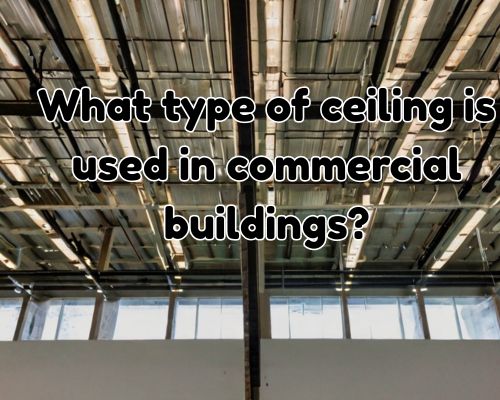
What Type of Ceiling Is Used in Commercial Buildings? A Deep Dive for New Jersey Property Owners
What Type of Ceiling Is Used in Commercial Buildings? A Deep Dive for New Jersey Property Owners
In the ever-evolving landscape of commercial construction, one foundational yet often overlooked element is the type of ceiling used. If you’re a business owner, property manager, or developer in New Jersey, understanding ceiling systems isn’t just a matter of aesthetics—it affects acoustics, energy efficiency, compliance, and long-term value. So, what type of ceiling is used in commercial buildings? The answer isn’t one-size-fits-all. With Charles Jimerson of CJ Commercial Roofing NJ, let’s break it down by ceiling types, their uses, and what makes certain options more popular across New Jersey’s commercial properties.

Why Ceiling Types Matter in Commercial Construction
Before diving into the materials and designs, it’s essential to understand why ceiling choices are critical. In commercial buildings—whether office complexes in Newark, retail stores in Jersey City, or industrial warehouses in Trenton—ceilings play a functional and architectural role. They:
- Conceal mechanical systems like HVAC ducts, wiring, and sprinkler lines
- Improve acoustics by reducing sound transmission
- Contribute to fire safety and code compliance
- Influence lighting layout and energy efficiency
- Impact maintenance access and cost-effectiveness
With New Jersey’s diverse architectural zones—from the tech-centric corridors of Princeton to the bustling logistics hubs in Elizabeth—ceiling requirements vary by industry and local regulation.
The Most Common Types of Commercial Ceilings Used in New Jersey
1. Suspended (Drop) Ceilings
One of the most frequently used ceiling systems in commercial buildings across New Jersey is the suspended ceiling, also known as a drop ceiling. This system consists of a metal grid suspended from the structural ceiling, into which acoustic tiles or panels are laid.
Why it’s popular:
- Easy access to plumbing, wiring, and HVAC systems
- Excellent for sound absorption—great for office environments
- Cost-effective installation and repair
Common materials:
- Mineral fiber tiles
- Fiberglass panels
- PVC (for moisture-prone areas like commercial kitchens)
In office parks near Edison or Paramus, drop ceilings are often chosen for their versatility and professional look, especially when paired with recessed lighting or modular air diffusers.
2. Exposed Structural Ceilings
More recently, industrial-style aesthetics have made exposed ceilings a trendy choice, especially in tech startups and creative agencies located in hubs like Hoboken or Montclair.
What it means:
This design exposes the building’s structure—steel beams, ducts, and conduits—painting or treating them for aesthetic and protective purposes.
Pros:
- Aesthetically modern and spacious
- Eliminates material costs of drop tiles
- Easier mechanical reconfiguration
Cons:
- Acoustic treatment is usually necessary
- Requires precision in construction and safety compliance
This type of ceiling is often seen in coworking spaces and converted lofts throughout urban redevelopment zones in Newark and Asbury Park.
3. Acoustic Ceilings
Acoustic ceiling tiles are designed specifically for sound control, making them essential in spaces like medical offices, call centers, and schools throughout New Jersey.
Key materials include:
- Perforated gypsum
- Acoustic mineral wool
- Wood-fiber composite panels
In compliance-heavy regions like Camden County, choosing the right NRC (Noise Reduction Coefficient)-rated ceiling material can influence zoning approvals or tenant agreements.
4. Metal Ceilings
Yes, metal ceilings are very much alive and relevant—particularly in transport terminals, corporate lobbies, and healthcare facilities across New Brunswick and Atlantic City.
Benefits:
- Long lifespan and minimal maintenance
- Fire-resistant and mold-resistant
- Highly customizable finishes (perforated, brushed, or coated)
Aluminum and galvanized steel are the most common options here. While the cost may be higher upfront, the ROI in durability makes this option popular in sectors that emphasize hygiene and resilience, such as hospitals and pharmaceutical offices.
5. Gypsum and Plaster Ceilings
Traditional but still in use, gypsum board ceilings (drywall ceilings) are favored for spaces requiring a smooth, monolithic finish—think bank branches, legal offices, or upscale boutiques in Morristown or Red Bank.
Advantages:
- Excellent for fire-rating and insulation
- Allows for custom molding and designs
- Compatible with LED lighting installations
Drawbacks:
- Limited access to above-ceiling systems
- Costlier to modify post-installation
While not as modular as drop ceilings, they lend a premium finish suited to brand-conscious businesses. For more, visit https://cjcommercialroofingnj.com/.
Local Considerations: Why New Jersey’s Commercial Ceilings Require Extra Attention
1. Code Compliance
New Jersey adheres to the International Building Code (IBC), but with amendments specific to the state. Commercial ceiling installations must comply with:
- Fire ratings and smoke development index
- Seismic zone considerations (especially in multi-story buildings)
- Acoustic privacy in mixed-use zones
Always consult with a licensed New Jersey commercial contractor familiar with municipal permits and inspection protocols.
2. Climate and Energy Efficiency
Given New Jersey’s humid subtropical climate, ceiling materials must tolerate moisture and thermal cycling. Ceilings that support insulated HVAC distribution and LED lighting integration are favored to meet energy efficiency mandates under the New Jersey Clean Energy Program.
Which Ceiling Type Is Best for Your Commercial Building in New Jersey?
There’s no single “best” ceiling type—it depends on:
- Your industry (office, retail, healthcare, hospitality, etc.)
- Building age and structure
- Local code requirements
- Desired aesthetics and acoustic performance
- Budget and maintenance expectations
If you’re building or renovating in areas like Cherry Hill, Hackensack, or Somerville, you’ll want to work with ceiling contractors who understand both form and function, especially those offering BOMA-compliant (Building Owners and Managers Association) solutions.
Final Thoughts: Elevate Your Ceiling, Elevate Your Business
The ceiling of a commercial space does more than cap a structure—it shapes how your business is perceived and how it functions. Whether you’re revamping an old warehouse in Paterson or outfitting a new office in Toms River, selecting the right ceiling type ensures comfort, compliance, and cost efficiency.
So, when asking, “What type of ceiling is used in commercial buildings?” in New Jersey, the real answer is: the one that meets your functional needs, satisfies local codes, and enhances your brand’s identity from the top down.